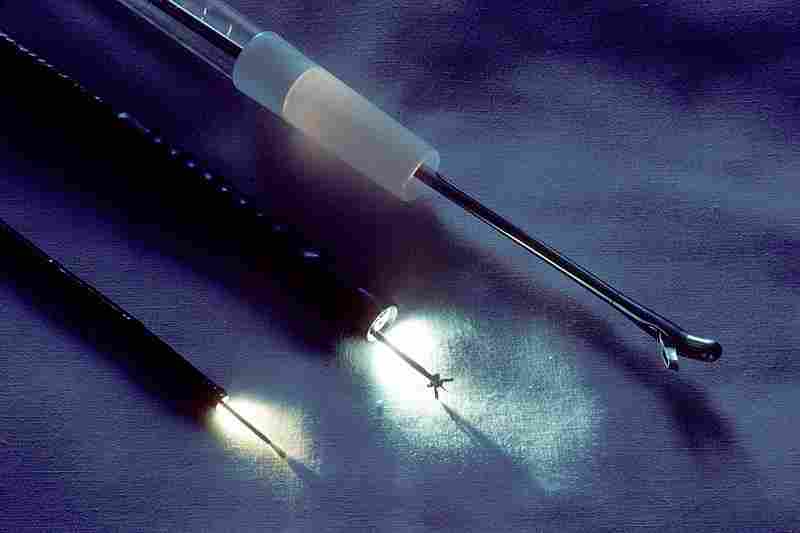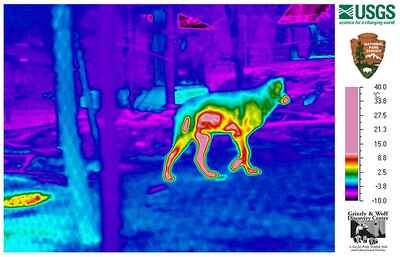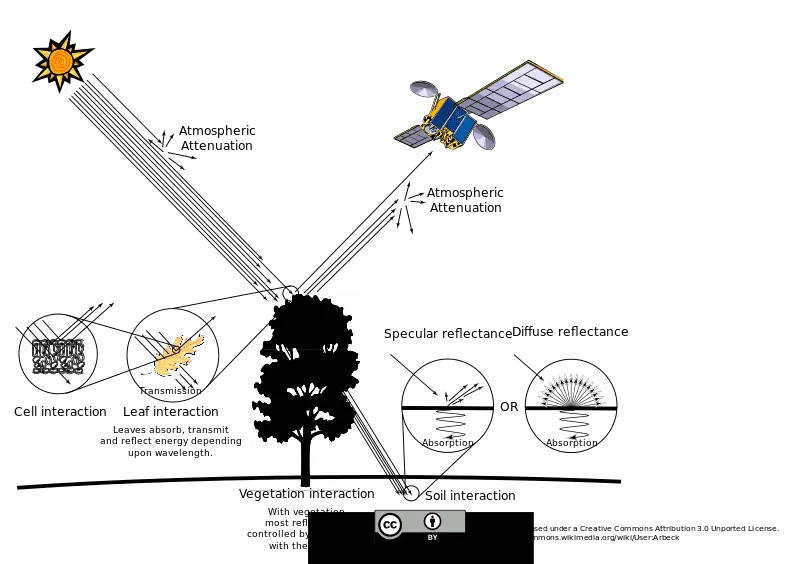7 Examples of Infrared Radiation Sources and Applications
Examples of infrared radiation include solar infrared, fire-emitted infrared, thermal imaging cameras, infrared lamps, optical fibers, remote control-electromagnetic waves, and infrared cookers.
This article discusses the examples of infrared radiation in terms of its sources and applications, as follows;
1). Solar Infrared (as one of the Examples of Infrared Radiation)
Infrared radiation, often described simply as "infrared," is a type of electromagnetic radiation that is characterized by longer wavelengths than visible light [5].
It is part of the electromagnetic spectrum, and falls between microwaves and visible light.
Infrared is contained in the solar-EM spectrum, and plays a notable role in the energy-balance and climatic conditions of the Earth.
Source and Mechanism of Solar Infrared Radiation
Solar infrared radiation comes from the Sun; which is also the primary source of energy for the Earth.
The Sun emits a broad range of electromagnetic waves, including visible light, ultraviolet (UV) radiation, and infrared radiation respectively [18].
When solar radiation reaches the Earth, it is absorbed by the surface of the planet, resulting in temperature increase (with thermal energy assimilation). The Earth subsequently re-emits this absorbed energy, in the form of longer-wavelength infrared radiation, also referred to as longwave radiation [22].

Role/Function(s) of Solar Infrared Radiation
Infrared radiation is vital for its multiple functions and contributions, which include heat-energy transfer, greenhouse effect, and climate regulation.
Heat transfer on Earth is carried out mainly through the propagation of invisible infrared radiation.
As the Earth's surface absorbs solar energy during the day, it warms up, and emits heat in the form of infrared radiation, during the night [15]. This dynamic of absorption and emission, helps maintain the planet's temperature balance.
The greenhouse effect also relies on infrared radiation as a central element.
Natural greenhouse processes, keep the Earth's surface at temperatures warm enough to support life. Certain gases in the atmosphere, like water vapor and carbon dioxide, are capable of absorbing and re-radiating significant amounts of infrared radiation [23]. This mechanism traps heat close to the Earth's surface, and prevents it from escaping into space.
Infrared radiation is important for regulating climatic conditions on Earth. It contributes to the complex thermodynamic interactions that occur between the atmosphere, wind, land surfaces and oceans, which control trends in the planet's overall temperature.
Overview of Infrared Solar Radiation
Infrared solar radiation refers to the portion of solar radiation emitted by the Sun, that falls within the infrared wavelength-and-frequency range.
It is a form of electromagnetic radiation whose characteristics include longer wavelengths than visible light, and shorter wavelengths than microwaves.
Infrared solar radiation is responsible for the heating Earth's surface, which typically absorbs and re-emits this heat in the form of longwave infrared radiation.
2). Fire-Emitted Infrared
Infrared radiation is invisible to the human eye but can be felt as heat.
All objects whose temperatures exceed absolute zero emit some amount of infrared radiation as a result of their thermal stored-energy [17].
Fire; a result of the release of energy during combustion, is a prominent source of infrared radiation, and acts as an effective medium of heat generation and energy transfer.
Fire as a Source of Infrared Radiation
Fire is a thermodynamic product of chemical reaction that occurs when combustible fuel (such as wood/biofuel, natural gas, petroleum products, or paper) combines with oxygen in the presence of heat.
During this process of combustion, the molecules of the burning material become excited, and as they return to their normal state, they emit energy in the form of electromagnetic radiation, whose wavelength-range includes visible light and infrared radiation [19].

Function(s) and Mechanisms of Infrared Radiation in Fire
Infrared radiation in fire, is associated with functions, mechanisms and applications like heat-transfer, energy release, and thermal detection.
The emission of infrared radiation by a fire is an effective mechanism of heat transfer.
As the flames burn, they emit infrared radiation that travels in waveform, through space. When these waves come into contact with surfaces or objects in their path, they are absorbed, and the energy in them cause vibrations in the molecular lattice of the surface or object; which are measured as heat, of increase in temperature of the object.
The above explanation shows that infrared radiation is one of the mediums through which a fire releases the energy generated from breakdown of chemical bonds in materials during combustion.
This energy radiates outward, exerting a warming-effect on the surrounding environment and producing to the heat and light typically associated with fires.
Specialized methods and equipment like thermal imaging camera, are used to detect Infrared radiation emitted by a fire. This technology is utilized by firefighters to assess the intensity, an identify the location of fires, even in situations where visibility is poor due to smoke [3].
Overview of Fire as an Example of Infrared Radiation Sources
Fire is an example of a source that emits infrared radiation as a result of chemical reaction.
The process of combustion in a fire releases energy; a portion of which is emitted as electromagnetic radiation, including infrared waves.
Fire emits infrared radiation as one of the wavelengths of energy that it releases from thermal decomposition of substrates, during the combustion process. It is a significant component of energy from flames, along with other forms of electromagnetic radiation, like visible light.
Types of electromagnetic radiation emitted by fire include "visible light," "infrared light," and "ultraviolet light" (in cases of extreme heat-release [8]. However, the most dominant form of radiation emitted by fire is infrared, which is responsible for the warmth and heat felt in proximity to flames.
3). Thermal Imaging Cameras (as one of the Examples of Infrared Radiation)
Thermal imaging cameras, also referred to as thermal imagers or infrared cameras, use the infrared radiation emitted by objects to produce images based on their heat signatures [21].
Since all objects with a temperature above absolute zero can emit infrared rays, virtually any (unfrozen, unhidden, unburied) object on Earth can be detected by these specialized cameras.
Primary Role of Infrared Radiation in Thermal Imaging Cameras
The primary role of infrared radiation in thermal imaging cameras, is to create temperature differences in the environment that can be detected, measured and visualized.
These cameras detect the thermal variations in infrared radiation emitted by different zones or objects, convert the variations detected into electrical signals, and then create images that depict the spatial distribution of temperature across the scene.

This imaging technology is used productively in diverse applications, including industrial inspection and quality assessment, medical diagnostics, and surveillance [14].
Overview of Key Points Related to Infrared Radiation from Thermal Imaging Cameras
Thermal imaging cameras use infrared radiation to function. These cameras detect and estimate the infrared energy emitted by objects, using derived signals to create thermal images that reveal differential patterns in the spatial distribution of temperature.
The primary type of radiation used in thermal imaging cameras is therefore infrared; which is also known as thermal radiation, that is released by objects due to their temperature.
4). Infrared Lamps
Infrared lamps are electrical devices which are designed to emit infrared radiation as a form of energy for heating purposes [10].
The primary source of infrared radiation in these lamps, is the heating element within the device itself, which is powered by electricity.
When an electrical current flows through the heating element, its temperature increases significantly, so that it begins to emit infrared rays.
Role of IR in Infrared Lamps
The main role of infrared radiation in infrared lamps is heat production.
Invisible infrared radiation is a form of electromagnetic energy that can cause increase in temperature. This is used in infrared lamps to provide heat that can be directed towards a specific area or object.
Infrared lamps are useful in various applications, including industrial processes, therapeutic and agricultural uses.
Radiant heating systems commonly use infrared lamps [16], which emit infrared waves that directly heats objects without causing significant warming of the surrounding air.
This efficiency of operation, makes such systems effective for localized heating in outdoor environments or indoor spaces.
Infrared lamps are utilized in industrial processes that require efficient heating under controlled conditions. Examples of tasks in which they are used include; curing drying, heating and melting of materials in production and manufacturing processes.
Therapeutic uses also exist for infrared lamps, such as is observed in some aspects of physiotherapy, with the implementation of LED-based photobiomodulation (PBM) therapy [13].
Radiant heat from these lamps are able to penetrate the skin and provide a warming effect that may alleviate muscle tension and promote relaxation among other health benefits.

Agricultural applications of infrared lamps include the provision of supplemental heating to plants or livestock in controlled environments, such as animal enclosures and greenhouses.
Benefits of Infrared Lamps
Benefits of infrared lamps include; rapid heating, direction thermal application, energy conservation and reduced air-movement.
Rapid heating is possible with infrared lamps, which can quickly heat-up objects without warming the surrounding air [24], making them effective and energy-efficient for targeted heating.
The above can summarily be described as directional heating capability. Heat emitted by infrared lamps can be directed with precision where it is needed, in such a manner that minimizes energy wastage.
Unlike forced-air heating systems, infrared lamps do not cause dust circulation or create air currents, which is a huge advantage in certain applications.
5). Optical Fibres (as one of the Examples of Infrared Radiation)
Optical fibers are thin, transparent and flexible strands of plastic or glass that are used to transmit light signals over long distances [7].
Infrared (IR) optical fibers are specifically designed to transmit radiation with wavelengths greater than approximately 2.2 μm, which falls within the infrared spectrum [4].
Infrared radiation is emitted by various sources, including natural sources like the Sun and artificial sources like lasers and heaters.
Role of Infrared Radiation in Optical Fibers
In the realm of optical fibers, infrared radiation is effective for transmitting signals over long distances with minimal loss of information.
Infrared radiation is used with optical fibers in fiber-optic communication, medical applications, material science and research, and astronomical instruments.
Fiber optic communication involves the use of longer wavelengths within the IR spectrum, for transmitting data through optical fibers [25].
The effectiveness of this technology can be attributed to the advantageous properties of IR light, including lower absorption (attenuation) in the fiber, which enables signals to travel longer distances without significant loss.
In fiber optic communication systems, infrared light is utilizer for encoding and transmitting data, which makes it a fundamental component of modern telecommunications.
Medical applications involving fiber optics may also utilize Infrared radiation. For example, medical devices like endoscopes, often employ optical fibers to transmit infrared light for therapeutic purposes or internal imaging of the body [12].

Another area of application of infrared radiation is in material-science research, where some types of fibers can be designed to be transparent to specific infrared wavelengths. This is particularly useful for evaluating the properties of materials in the IR spectrum.
Lastly, optical fibers with infrared radiation, especially in the longer wavelengths, can also be used in astronomical telescopes. These telescopes capture infrared rays emitted by celestial bodies, enabling astronomers to study objects in the absence of sufficient visible light.
Benefits of Using Infrared in Optical Fibers
The use of infrared radiation in optical fibers offers multiple benefits, including long-distance transmission, enhanced data capacity, and safe endoscopic imagery.
Long-distance transmission with minimal loss of energy is possible using IR optical fibers, due to the low attenuation rate of infrared light [9].
Data capacity in optical communication systems improves with the use of IR wavelengths, as a result of the relatively high data-carrying capacity of IR waves.
In medical imaging applications, the ability of infrared light to penetrate tissues without causing harm is also a huge advantage.
Overview of Key Points in the Discussion of Infrared Optical Fibers
Optical fibers can transmit various wavelengths of light, and other waves in the electromagnetic spectrum, including infrared.
The type of radiation used in optical fiber communication, depends on desired performance and available technologies; and may include EM waves that range within values of 850 nm, 1310 nm, and 1550 nm, referred to as the near infrared range [1].
In fiber optics, infrared plays the role of long-distance transmission medium, due to its low absorption and attenuation attributes.
6). Remote Control-Electromagnetic Waves
Infrared radiation is a vital electromagnetic component in remote control technology [11].
The suitability of IR for remote control applications can be traced to its attributes, including its wavelength(s), frequency, propagative mechanisms, and attenuation properties.
Invisibility, detectability, and efficient transmission all make infrared radiation ideal for tasks involving the transmission of signals.
How Infrared is Used in Remote Control Technology
Remote controls, such as those for television sets, use infrared radiation to carry out instructions through wireless communication.
The process by which infrared is used in remote control technology, involves steps like transmission, reception, communication, detection, and execution. They are summarily discussed below.
The remote control functions as a transmitter. Its components include a Light-Emitting Diode (LED) that is configured to emit bursts of infrared light when a button is pressed.

Receiver device, is the device that depends on IR interactions with the remote, for its wireless operation.
This device could an electronic/electrical appliance like a TV. It is able to act as a receiver because it possesses sensor components that detect the infrared light signals from the remote controller.
Wireless communication occurs between the transmitter and receiver when a button is pressed on the remote control, causing the LED to emit a series of rapid infrared light-pulses. These pulses carry specific codes that give command signals (like changing a channel) to the receiver [20].
Two key requirements for infrared wireless remote control are; IR detection and command execution.
Detection is the role of the sensor(s) in the device's receiver, which detect the incoming infrared light pulses from the remote controller. On detection, it proceeds to decode these pulses into corresponding commands that can be executed by the device.
The device then executes the decoded command, such as volume adjustment, changing the channel, or any other function associated with the pressed button.
Benefits of The Use of Infrared in Remote Control
Benefits associated with using infrared radiation in remote control technology include; wireless control, convenience and versatility.
Wireless control through communication between remote controllers and devices, is possible using infrared technology. This eliminates the need for physical proximity or cumbersome wire-connections.
With IR remote controls, users gain the convenient advantage of operating electronic devices from a distance.
Lastly, infrared wireless technology is versatile and can be used for diverse types of remote-controlled devices, from air conditioners and TVs to large-scale industrial systems.
Overview of Key Concepts Related to Infrared Remote Control
In remote controls, infrared radiation is emitted by an LED that is part of the remote control circuit. This infrared light transmits commands to devices which are equipped with infrared sensors, that detect the rays and execute the encoded commands.
Infrared is the type of radiation which remote controls primarily use, specifically near-infrared light, which is efficient as a medium for transmitting commands to devices.
7). Infrared Cookers (as one of the Examples of Infrared Radiation)
An infrared cooker is an innovative kitchen appliance which uses infrared radiation to provide heat for cooking food.
The internal configuration of an infrared cooker typically includes an infrared burner, and halogen lamps [2]. The top surface of the cooker features a ceramic plate that has microscopic holes.
Heat energy provides by the burner is converted into infrared heat by the internal circuitry, which is then directed towards the food.
Role of Infrared Radiation an an Energy-Form, in The Infrared Cooker
Infrared radiation acts as the primary form of energy, in the cooking process of an infrared cooker.
When heat is generated by the halogen lamps and infrared burner, this heat energy is converted into infrared radiation.
Unlike conventional cooking methods that depend on direct contact between the heat source and the food, infrared radiation heats the food through a contactless, radiant mechanism of thermal energy transfer.
The microscopic holes on the top-surface ceramic plate, help to disperse the infrared energy evenly across the cooking surface, to ensure uniform cooking of the food.
Illustrative Examples of Infrared Radiation in Cooking
One example of the use of infrared radiation in cooking is broiling.
In broiling, food is cooked by exposing it to a heat source from above [6]. This method is the inverse to grilling, and is often used for cooking items like steaks, fish fillets and chicken breasts.
Another example is cooking food on a spit over a campfire, where radiant heat emitted by the fire cooks the food.

Overview of Key Points in Infrared Cooking Applications
Broiling, grilling, and the use of a spit over campfire; are examples of infrared radiation in cooking.
In all these examples, food is cooked through radiant thermal transfer, by exposing it to a heat source from above or below.
An infrared cooker uses infrared radiation for cooking. Here, the term "radiation" refers to the process of emitting energy as electromagnetic waves that propagate through space, rather than harmful ionizing radiation. Infrared radiation is used to heat and cook food in the infrared cooker.
Conclusion
Examples of infrared radiation are;
1. Solar Infrared
2. Fire-Emitted Infrared
3. Thermal Imaging Cameras
4. Infrared Lamps
5. Optical Fibres
6. Remote Control-Electromagnetic Waves
7. Infrared Cookers
Solar infrared refers to the portion of infrared radiation emitted by the Sun. It plays a crucial role in Earth's energy balance, warming the planet's surface and contributing to various atmospheric processes.
Fire emits infrared radiation as a form of heat energy. Infrared radiation from fires is used for various applications, including remote sensing, temperature measurements, and cooking.
Thermal imaging cameras detect and capture infrared radiation emitted by objects based on their temperature. These cameras are used for various purposes, such as night vision, surveillance, and diagnosing heat-related issues in machinery.
Infrared lamps emit infrared radiation, which is used for heating applications. These lamps are commonly used in radiant heating systems, industrial processes, and even in cooking appliances.
Infrared optical fibers transmit infrared radiation, enabling communication and data transfer using infrared light. They are used in various fields, including telecommunications, medical devices, and remote sensing.
Remote controls use infrared radiation as a medium to transmit signals to devices. Infrared waves carry control commands from the remote control to the receiving device, such as a television.
Infrared cookers use infrared radiation to cook food. The internal structure of these cookers includes halogen lamps and an infrared burner, which convert heat energy into infrared radiation for even and efficient cooking.
Infrared waves are a versatile form of electromagnetic radiation with applications ranging from energy transfer and communication to sensing and cooking.
References
1). Addanki, S.; Amiri, I. S.; Yupapin, P. (2018). "Review of Optical Fibers-Introduction and Applications in Fiber Lasers." Results in Physics 10. Available at: https://doi.org/10.1016/j.rinp.2018.07.028. (Accessed 11 August 2023).
2). Alpay, Y.; Uygur, I.; Kılınçel, M.; Samtaş, G. (2023). "Cure cycle optimization of infrared cured composites using Taguchi method." Journal of Applied Polymer Science 140(22). Available at: https://doi.org/10.1002/app.53922. (Accessed 11 August 2023).
3). Amon, F.; Bryner, N.; Hamins, A. (2004). "Evaluation of thermal imaging cameras used in fire fighting applications." Proceedings of SPIE - The International Society for Optical Engineering 5407. Available at: https://doi.org/10.1117/12.564331. (Accessed 11 August 2023).
4). Artyushenko, V.; Bocharnikov, A.; Sakiharova, T.; Usenov, I. (2014). "Mid-infrared Fiber Optics for 1 — 18 μm Range." Available at: https://doi.org/10.1002/opph.201400062. (Accessed 11 August 2023).
5). Austin, E.; Geisler, A.; Nguyen, J.; Kohli, I.; Hanzavi, I.; Lim, H. W.; Jagdeo, J. (2021). "Visible Light Part I. Properties and Cutaneous Effects of Visible Light." Journal of the American Academy of Dermatology 84(5). Available at: https://doi.org/10.1016/j.jaad.2021.02.048. (Accessed 11 August 2023).
6). Chavan, A. (2021). "CH NO4 Chapter 4 Methods of Cooking." 000 (pp.27). Available at: https://www.researchgate.net/publication/348097164_CH_NO4_Chapter_4_Methods_of_Cooking. (Accessed 11 August 2023)..
7). Fenta, M. C.; Szanyi, J. (2021). "Fibre Optic Methods of Prospecting: A Comprehensive and Modern Branch of Geophysics." Springer, Surveys in Geophysics. Available at: https://doi.org/10.1007/s10712-021-09634-8. (Accessed 11 August 2023).
8). Hudson, M. K.; Shanks, R. B.; Snider, D.; Lindquist, D. M.; Luchini, C.; Rooke, S. (1998). "UV, Visible, and Infrared Spectral Emissions in Hybrid Rocket Plumes." International Journal of Turbo and Jet Engines 15(1). Available at: https://doi.org/10.1515/TJJ.1998.15.1.71. (Accessed 11 August 2023).
9). Krenz, P. M.; Olmon, R. O.; Lail, B.; Raschke, M.; D Boreman, G. D. (2010). "Near-field measurement of infrared coplanar strip transmission line attenuation and propagation constants." Optics Express 18(21):21678-86. Available at: https://doi.org/10.1364/OE.18.021678. (Accessed 11 August 2023).
10). Logerais, P.-O.; Bouteville, A. (2010). "Modelling of an infrared halogen lamp in a rapid thermal system." International Journal of Thermal Sciences 49(8):1437-1445. Available at: https://doi.org/10.1016/j.ijthermalsci.2010.03.003. (Accessed 11 August 2023).
11). Mbunwe, M. (2017). "Design and Construction of a remote control switching device for household appliances application." Advances in Science Technology and Engineering Systems Journal 2(4):154-164. Available at: https://doi.org/10.25046/aj020421 (Accessed 11 August 2023).
12). Piao, D.; Xie, H.; Zhang, W.; Krasinski, J.; Zhang, G.; Dehghani, H.; Pogue, B. (2006). "Endoscopic, rapid near-infrared optical tomography." Optics Letters 31(19):2876-8. Available at: https://doi.org/10.1364/OL.31.002876. (Accessed 11 August 2023).
13). Pruitt, T.; Carter; C.; Wang, X.; Wu, A ; Liu, H. (2022). "Photobiomodulation at Different Wavelengths Boosts Mitochondrial Redox Metabolism and Hemoglobin Oxygenation: Lasers vs. Light-Emitting Diodes In Vivo." Metabolites 12(2):103. Available at: https://doi.org/10.3390/metabo12020103. (Accessed 11 August 2023).
14). Rai, M. (2018). "Thermal imaging system and its real time applications: a survey." Journal of Engineering Technology 62(2). Available at: https://www.academia.edu/39845463/Thermal_imaging_system_and_its_real_time_applications_a_survey. (Accessed 11 August 2023).
15). Rhodes, C. J. (2010). "Solar energy: principles and possibilities." Sci Prog. 2010;93(Pt 1):37-112. Available at: https://doi.org/10.3184/003685010X12626410325807. (Accessed 11 August 2023).
16). Sattar, S.; Al-Khafaji, Z.; Falah, M. W. (2022). "Sustainable heating system by infrared radiators." Heritage and Sustainable Development ISSN 2712-0554 Vol. 4,(No. 1):42-52. Available at: https://doi.org/10.37868/sei.v4i1.id82. (Accessed 11 August 2023).
17). Speakman, J.; Ward, S. (1998). "Infrared thermography: Principles and applications" Zoology 101(3):224-232. Available at: https://www.academia.edu/4686615/Infrared_thermography_principles_and_applications. (Accessed 11 August 2023).
18). Sterhov, A. I.; Loshkarev, I. Y. (2019). "Determination of the proportion of natural light in solar radiation using the method of conversion of lighting units into energy." Journal of Physics: Conference Series, Volume 1353, International Conference "High-tech and Innovations in Research and Manufacturing (HIRM-2019)" 6 May 2019, Krasnoyarsk, Russian Federation. Available at: https://doi.org/10.1088/1742-6596/1353/1/012002. (Accessed 11 August 2023).
19). Steward, B. J.; Perram, G.; Gross, K. C. (2011). "Visible and Near-Infrared Spectra of the Secondary Combustion of a 152 mm Howitzer." Applied Spectroscopy 65(12):1363-1371. Available at: https://doi.org/10.1366/11-06445. (Accessed 11 August 2023).
20). Thotakanama, N. K.; Prajwal, K. T. (2019). "Design and Development of Low Cost IR based Home Automation System." Available at: https://www.researchgate.net/publication/332440048_Design_and_Development_of_Low_Cost_IR_based_Home_Automation_System. (Accessed 11 August 2023).
21). Uzair, M.; Brinkworth, R. S. A.; Finn, R. A. (2021). "Detecting Small Size and Minimal Thermal Signature Targets in Infrared Imagery Using Biologically Inspired Vision." Sensors 21(5):1812. Available at: https://doi.org/10.3390/s21051812. (Accessed 11 August 2023).
22). Wei, P.-S.; Hsieh, Y.-C.; Chiu, H.-H.; Yen, D.-L.; Lee, C.; Tsai, Y.-C.; Ting, T.-C. (2018). "Absorption coefficient of carbon dioxide across atmospheric troposphere layer." Heliyon 4(10):e00785. Available at: https://doi.org/10.1016/j.heliyon.2018.e00785. (Accessed 11 August 2023).
23). Wei, P.-S.; Chiu, H.-H.; Hsieh, Y.-C.; Yen, D.L.; Lee, C.; Tsai, Y.-C.; Ting, T.-C. (2019). "Absorption coefficient of water vapor across atmospheric troposphere layer." Heliyon 5(1):e01145. Available at: https://doi.org/10.1016/j.heliyon.2019.e01145. (Accessed 11 August 2023).
24). Yadav, G.; Gupta, N.; Sood, M.; Anjum, N.; Chib, A. (2020). "Infrared heating and its application in food processing." Available at: https://www.researchgate.net/publication/342493659_Infrared_heating_and_its_application_in_food_processing. (Accessed 11 August 2023).
25). Zlatanov, N. (2017). "Optical Communications and Amplifiers." The Optical Fiber Communication Conference and Exhibition, Los Angeles, CA. IEEE Computer Society. Available at: https://doi.org/10.13140/RG.2.2.18278.01603. (Accessed 11 August 2023).











